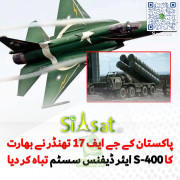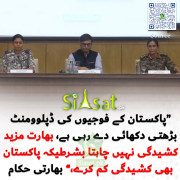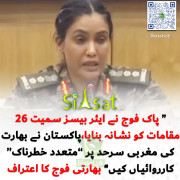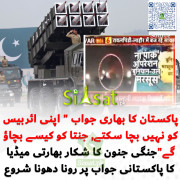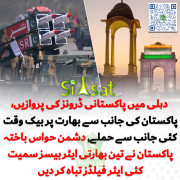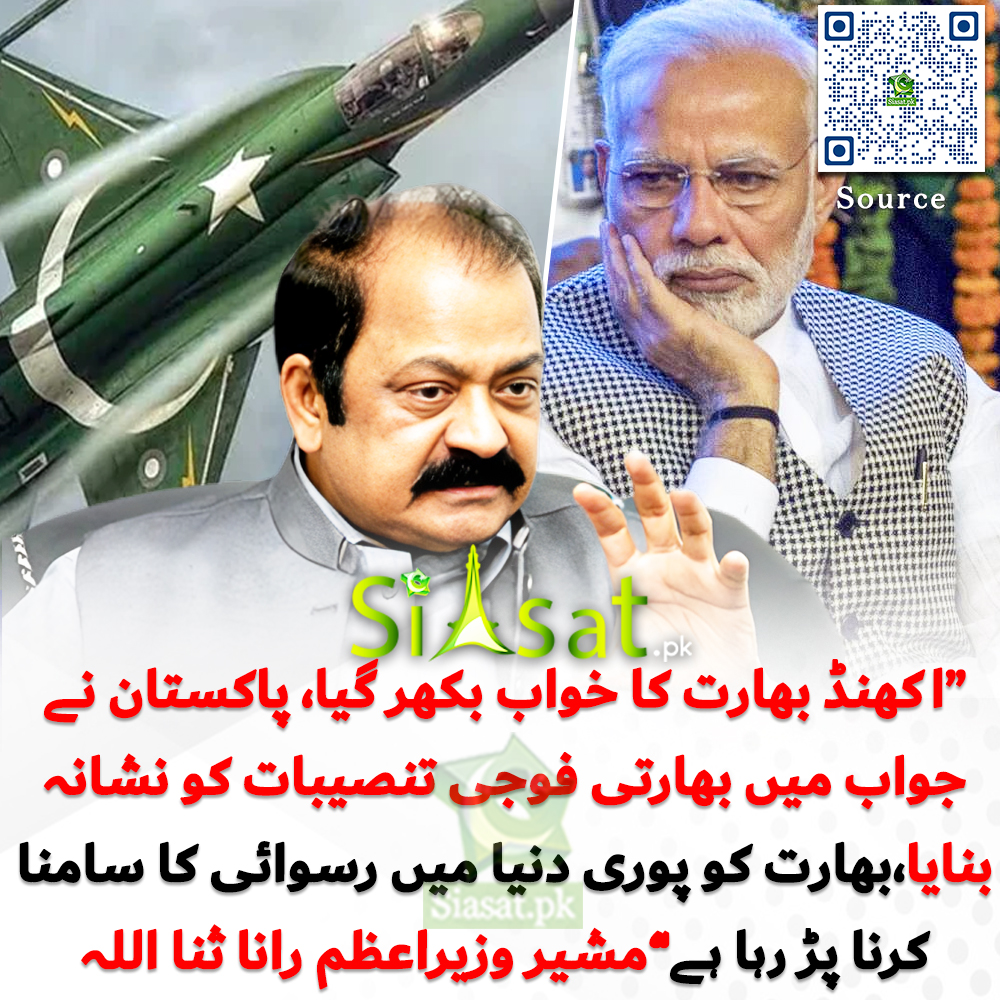C
commander
Guest
How leaders look and how they ought to
http://www.thenews.com.pk/daily_detail.asp?id=192190
Sunday, August 09, 2009
Aakar Patel
Ahmedinejad
Iran's President Ahmedinejad wears a jacket and trousers but never a tie. He wears his shirt with a couple of buttons undone, and looks like he's just finished work rather than about to do some. What is modern Iranian dress? I'm not sure. V S Naipaul when he visited Qum instantly saw that the thin gowns of Oxbridge would have come from the Islamic seminaries. The ayatollahs and their students reminded him of university.
Ahmedinejad represents the modern end of Iran's politics and so the western dress, but he's a bumpkin besides Khatami, who dressed like a mullah but was actually quite modern. What do other leaders dress like?
Hugo Chavez of Venezuela dresses (and speaks) like a lout. He wears nylon windcheaters and jeans, and that is no way for a head of state to appear in public. Muammar Qaddafi is eccentric and wears strange things, including photographs pinned to his breast. He has been in power so long (40 years) that he must not care about how he is seen. Fidel, beloved of the left and the only leader in the world called by his first name, wears fatigues and that's fine because he's a revolutionary.
Manmohan Singh
In India Congressmen would wear khadi after Gandhi's instruction and they still do. But that has made them the target of caricature. Cartoonists need do nothing more than sketch out a few lines that indicate a cap and a dhoti and the character of someone venal emerges. Manmohan Singh is thin, as intellectuals should be, and an unlikely looking Sikh. His uniform is white shalwar-kurta and sleeveless jacket, mainly light blue to match his turban, which, alas, is unable to hide a balding head. When abroad he wears a Nehru jacket. Obama was impressed by him, and rightly.
Obama
America's 44th president is lean and handsome and dresses conservatively. You never see on him any sign of flashiness, though he has the body to carry off anything. His modesty is not bogus. A picture of his on the campaign in 2007 showed him on the phone with his feet up on a desk. The photographer shot his shoes and remarked on the big hole in one of them. It was the second time he had resoled that shoe, Obama grinned and told her.
Musharraf
Musharraf looks comfortable in his suits, and his ties are Windsor-knotted, which is a fine thing. He is conscious of his head of hair and runs his fingers through it often, fluffing it up, as a much younger man would and as was the style in the mid-80s when centre-parting became popular for men on the subcontinent. Like Indira Gandhi, he dyes his hair except for one part. Indira left a streak near the middle, Musharraf leaves grey on his temples.
Benazir
Benazir was a fine leader and getting better with time, but she didn't dress well. She spoke English in the same sing-song way that upper-class Sindhi women in India do. She wore clothes made of the loud and shiny material which the subcontinent's Muslim women seem to prefer.
But bad attire could not hide the fact that she was strikingly handsome, especially in her early years. At Shimla with her father in 1972, she was only in her teens but her fragrant presence was noted by everybody, including serious chroniclers like Rajeshwar Dayal. Pakistani women mostly wear shalwar kurta. The shalwar is actually peasant's clothing in Punjab: what women who work in the fields wear. The urban Punjabi woman always wore a sari though we see that less and less in Pakistan. And, sadly because they're quite beautiful, few Pakistani women wear the sari in the Indian way, with waist and navel showing.
Quaid e Azam
Jinnah was stylish. He had an excellent body ("whippet-thin" is how one writer, I think Patrick French, described him) of a type that very few Indians have. He wore three-piece suits, flashy two-tone shoes and a monocle, which he started wearing early because he wished to appear serious. That gave him a certain Wodehousian appearance. He reminds me of the way my hero, the Edwardian character R Psmith, was described: tall, thin, sombre, formal in dress and correct in manner, monocle. Psmith of course was very funny but there's little evidence of humour in the Quaid.
He spoke and wrote with deliberation, and if we read his speeches and letters, they are taut and precise, with little of the meandering and flummery that comes naturally to us.
Jinnah chain-smoked Craven A cigarettes, which were made in Jamaica and were also favoured by de Gaulle. Nehru, incidentally, smoked 555s, while Churchill smoked cigarillos rolled in South India, and 47-ring Romeo y Julietas rolled in Cuba. Gandhi, always puritanical, smoked a couple of beedis in his youth and then tried to kill himself.
To return to the Quaid, Jinnah was conscious of how he was viewed and changed the spelling of his name to make it sound modern. From Mahmedali Jhinabhai Poonja, he became M A Jinnah in England. In Gujarati he used to sign his name with a Jh and a rolled N, so in English his father's name would spell something like Jhinhah bhai.
Many Gujaratis refer to him as Zihnha, because J is not a natural sound for some people. Stocky Narendra Modi looks like the brute he is. He has a peasant's face and wears kurtas that are half-sleeved, a trend he has started all other politicians' kurtas are full-sleeved. Though he professes RSS asceticism, Modi's clothes are expensive, and I asked a fellow journalist in Ahmedabad where they were from. "Zed Blue" he said. It struck me as being an odd name, till I passed the shop sign, Jade Blue.
Sonia Gandhi
Sonia Gandhi is refined. She wears lovely cotton saris with subtle designs and earthy borders, and she wears them well, better than most Indian women. She has the kind of body that few Indian women her age (she will turn 63 on December 9) have.
Gandhi
Gandhi, like Jinnah, wanted the world to know how serious he was; that he was what he wore. So he dressed like nobody dresses in India -- except Brahmins during a ceremony.
In England after meeting George V, Gandhi was asked by a reporter whether it was proper that he should have appeared before the king emperor in his state of undress. "His majesty wore enough for both of us," replied Gandhi.
We think of Gandhi as religious, which he was, but I have seen no photograph of him wearing a janoi, the sacred thread of the Dwijya, the twice-born, which as a Vaishya, a trader from the third-ranking caste, he was entitled to wearing. Nehru, to my astonishment, wore one though he said he was agnostic, and there's a picture in Mushirul Hasan's book The Nehrus that proves it. He was Brahmin, of course, and according to his best biographer Walter Crocker, had a razor-sharp mind.
Nehru
Nehru was also elegant, and wore what came to be known the world over as the Nehru jacket with his balding head covered by the white cotton cap that the peasants of Western Maharashtra wear. The Nehru jacket is essentially a short sherwani with a Chinese collar. Zulfikar Ali Bhutto forced his cronies Hafeez Pirzada, Rafi Raza to wear one, but with thick gold piping.
Asif Ali Zardari
Asif Ali Zardari's clothes are a little too rich-looking for a poor nation's president. He is quite handsome, though not as handsome as Ayub Khan, the best-looking Pakistani leader. I was delighted when he praised Sarah Palin's beauty by expressing his desire to hug her. That's precisely how a gentleman should behave, and no damage was done to Pakistan or the reputation of its men by Zardari's action.
Sometimes clothes make a statement so profound that it lives on after us, and makes sense only with time.
The great Abdus Salam won the Nobel prize for physics in 1979, the year Zia unfolded his Hudood ordinance and five years after Zulfikar Ali Bhutto's parliament unanimously apostatised Salam's (and Zafrullah Khan's) sect. He had every right to disown his nation, but Abdus Salam received his Nobel as a Pakistani, wearing a large turban and a sherwani. He also opened his pithy banquet speech in Urdu, and we can see his words on the Nobel website: 'Pakistan iss kay liye aap ka bahut mashkoor hai.' His superb Nobel lecture, on the contribution of all cultures to science, should be required reading for schoolchildren everywhere in the world.
Sharif brothers
Coming back to clothes, the Sharif brothers are too fat to look good though their clothes are expensive. They have more hair now of course, but less weight would improve their looks considerably.
There's one difference between the old days and the new, and it is that leaders then -- think of Gandhi, Jinnah, Nehru -- were thin.
The writer is director with Hill Road Media in Bombay. Email: aakar@ hillroadmedia.com
http://www.thenews.com.pk/daily_detail.asp?id=192190
Sunday, August 09, 2009
Aakar Patel
Ahmedinejad
Iran's President Ahmedinejad wears a jacket and trousers but never a tie. He wears his shirt with a couple of buttons undone, and looks like he's just finished work rather than about to do some. What is modern Iranian dress? I'm not sure. V S Naipaul when he visited Qum instantly saw that the thin gowns of Oxbridge would have come from the Islamic seminaries. The ayatollahs and their students reminded him of university.
Ahmedinejad represents the modern end of Iran's politics and so the western dress, but he's a bumpkin besides Khatami, who dressed like a mullah but was actually quite modern. What do other leaders dress like?
Hugo Chavez of Venezuela dresses (and speaks) like a lout. He wears nylon windcheaters and jeans, and that is no way for a head of state to appear in public. Muammar Qaddafi is eccentric and wears strange things, including photographs pinned to his breast. He has been in power so long (40 years) that he must not care about how he is seen. Fidel, beloved of the left and the only leader in the world called by his first name, wears fatigues and that's fine because he's a revolutionary.
Manmohan Singh
In India Congressmen would wear khadi after Gandhi's instruction and they still do. But that has made them the target of caricature. Cartoonists need do nothing more than sketch out a few lines that indicate a cap and a dhoti and the character of someone venal emerges. Manmohan Singh is thin, as intellectuals should be, and an unlikely looking Sikh. His uniform is white shalwar-kurta and sleeveless jacket, mainly light blue to match his turban, which, alas, is unable to hide a balding head. When abroad he wears a Nehru jacket. Obama was impressed by him, and rightly.
Obama
America's 44th president is lean and handsome and dresses conservatively. You never see on him any sign of flashiness, though he has the body to carry off anything. His modesty is not bogus. A picture of his on the campaign in 2007 showed him on the phone with his feet up on a desk. The photographer shot his shoes and remarked on the big hole in one of them. It was the second time he had resoled that shoe, Obama grinned and told her.
Musharraf
Musharraf looks comfortable in his suits, and his ties are Windsor-knotted, which is a fine thing. He is conscious of his head of hair and runs his fingers through it often, fluffing it up, as a much younger man would and as was the style in the mid-80s when centre-parting became popular for men on the subcontinent. Like Indira Gandhi, he dyes his hair except for one part. Indira left a streak near the middle, Musharraf leaves grey on his temples.
Benazir
Benazir was a fine leader and getting better with time, but she didn't dress well. She spoke English in the same sing-song way that upper-class Sindhi women in India do. She wore clothes made of the loud and shiny material which the subcontinent's Muslim women seem to prefer.
But bad attire could not hide the fact that she was strikingly handsome, especially in her early years. At Shimla with her father in 1972, she was only in her teens but her fragrant presence was noted by everybody, including serious chroniclers like Rajeshwar Dayal. Pakistani women mostly wear shalwar kurta. The shalwar is actually peasant's clothing in Punjab: what women who work in the fields wear. The urban Punjabi woman always wore a sari though we see that less and less in Pakistan. And, sadly because they're quite beautiful, few Pakistani women wear the sari in the Indian way, with waist and navel showing.
Quaid e Azam
Jinnah was stylish. He had an excellent body ("whippet-thin" is how one writer, I think Patrick French, described him) of a type that very few Indians have. He wore three-piece suits, flashy two-tone shoes and a monocle, which he started wearing early because he wished to appear serious. That gave him a certain Wodehousian appearance. He reminds me of the way my hero, the Edwardian character R Psmith, was described: tall, thin, sombre, formal in dress and correct in manner, monocle. Psmith of course was very funny but there's little evidence of humour in the Quaid.
He spoke and wrote with deliberation, and if we read his speeches and letters, they are taut and precise, with little of the meandering and flummery that comes naturally to us.
Jinnah chain-smoked Craven A cigarettes, which were made in Jamaica and were also favoured by de Gaulle. Nehru, incidentally, smoked 555s, while Churchill smoked cigarillos rolled in South India, and 47-ring Romeo y Julietas rolled in Cuba. Gandhi, always puritanical, smoked a couple of beedis in his youth and then tried to kill himself.
To return to the Quaid, Jinnah was conscious of how he was viewed and changed the spelling of his name to make it sound modern. From Mahmedali Jhinabhai Poonja, he became M A Jinnah in England. In Gujarati he used to sign his name with a Jh and a rolled N, so in English his father's name would spell something like Jhinhah bhai.
Many Gujaratis refer to him as Zihnha, because J is not a natural sound for some people. Stocky Narendra Modi looks like the brute he is. He has a peasant's face and wears kurtas that are half-sleeved, a trend he has started all other politicians' kurtas are full-sleeved. Though he professes RSS asceticism, Modi's clothes are expensive, and I asked a fellow journalist in Ahmedabad where they were from. "Zed Blue" he said. It struck me as being an odd name, till I passed the shop sign, Jade Blue.
Sonia Gandhi
Sonia Gandhi is refined. She wears lovely cotton saris with subtle designs and earthy borders, and she wears them well, better than most Indian women. She has the kind of body that few Indian women her age (she will turn 63 on December 9) have.
Gandhi
Gandhi, like Jinnah, wanted the world to know how serious he was; that he was what he wore. So he dressed like nobody dresses in India -- except Brahmins during a ceremony.
In England after meeting George V, Gandhi was asked by a reporter whether it was proper that he should have appeared before the king emperor in his state of undress. "His majesty wore enough for both of us," replied Gandhi.
We think of Gandhi as religious, which he was, but I have seen no photograph of him wearing a janoi, the sacred thread of the Dwijya, the twice-born, which as a Vaishya, a trader from the third-ranking caste, he was entitled to wearing. Nehru, to my astonishment, wore one though he said he was agnostic, and there's a picture in Mushirul Hasan's book The Nehrus that proves it. He was Brahmin, of course, and according to his best biographer Walter Crocker, had a razor-sharp mind.
Nehru
Nehru was also elegant, and wore what came to be known the world over as the Nehru jacket with his balding head covered by the white cotton cap that the peasants of Western Maharashtra wear. The Nehru jacket is essentially a short sherwani with a Chinese collar. Zulfikar Ali Bhutto forced his cronies Hafeez Pirzada, Rafi Raza to wear one, but with thick gold piping.
Asif Ali Zardari
Asif Ali Zardari's clothes are a little too rich-looking for a poor nation's president. He is quite handsome, though not as handsome as Ayub Khan, the best-looking Pakistani leader. I was delighted when he praised Sarah Palin's beauty by expressing his desire to hug her. That's precisely how a gentleman should behave, and no damage was done to Pakistan or the reputation of its men by Zardari's action.
Sometimes clothes make a statement so profound that it lives on after us, and makes sense only with time.
The great Abdus Salam won the Nobel prize for physics in 1979, the year Zia unfolded his Hudood ordinance and five years after Zulfikar Ali Bhutto's parliament unanimously apostatised Salam's (and Zafrullah Khan's) sect. He had every right to disown his nation, but Abdus Salam received his Nobel as a Pakistani, wearing a large turban and a sherwani. He also opened his pithy banquet speech in Urdu, and we can see his words on the Nobel website: 'Pakistan iss kay liye aap ka bahut mashkoor hai.' His superb Nobel lecture, on the contribution of all cultures to science, should be required reading for schoolchildren everywhere in the world.
Sharif brothers
Coming back to clothes, the Sharif brothers are too fat to look good though their clothes are expensive. They have more hair now of course, but less weight would improve their looks considerably.
There's one difference between the old days and the new, and it is that leaders then -- think of Gandhi, Jinnah, Nehru -- were thin.
The writer is director with Hill Road Media in Bombay. Email: aakar@ hillroadmedia.com

